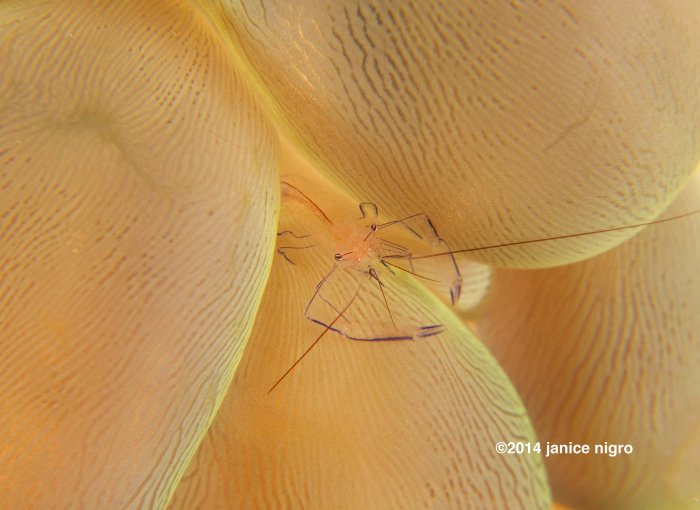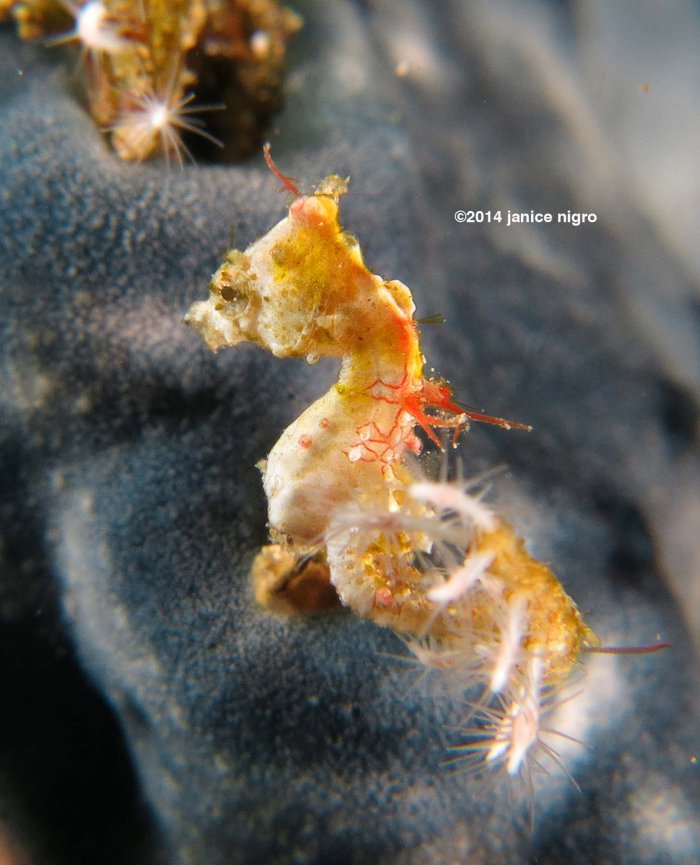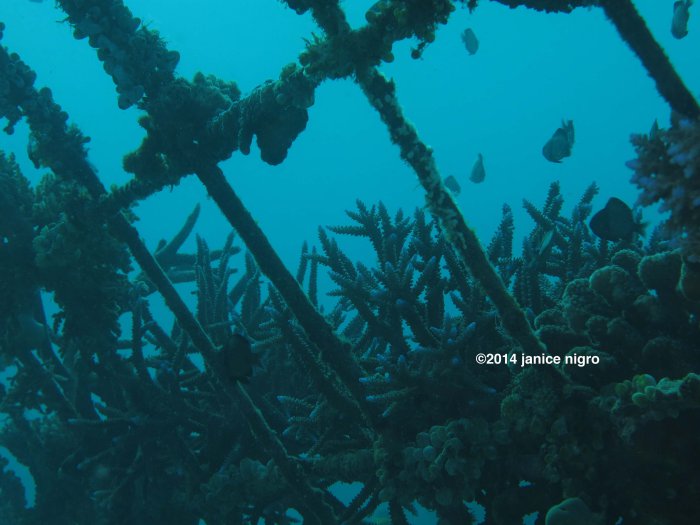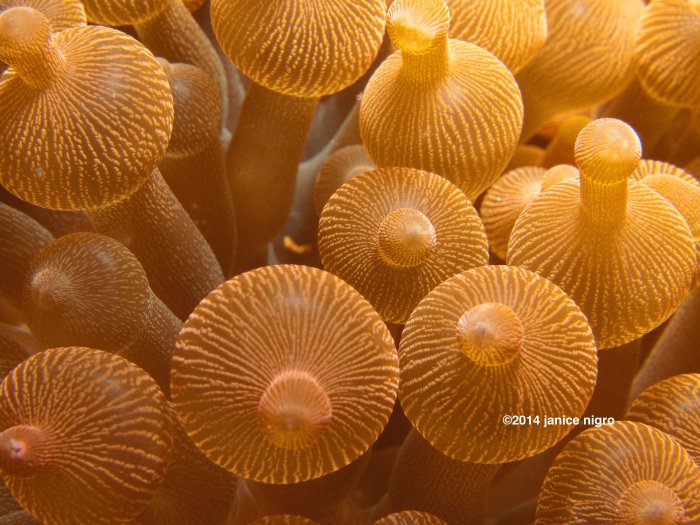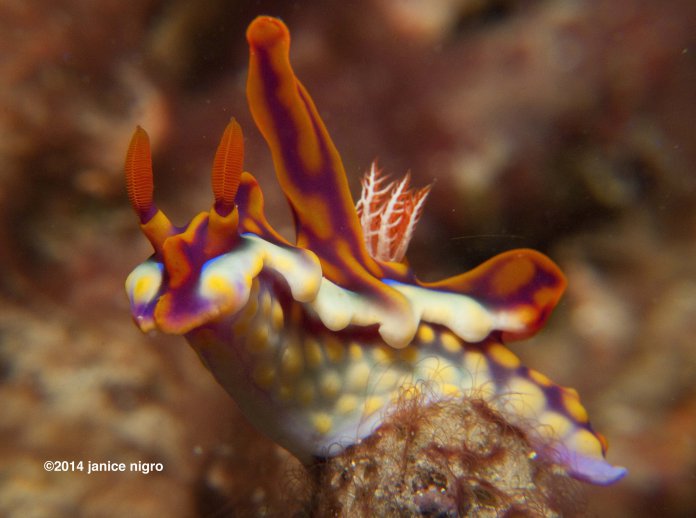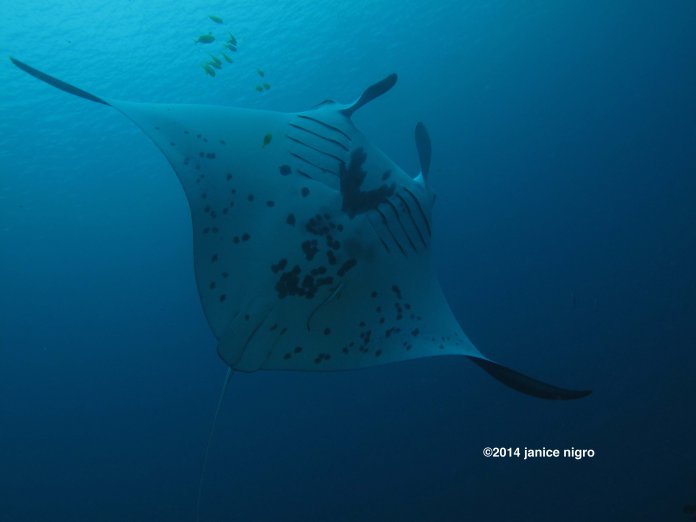News
Janice Nigro: My Dive Story
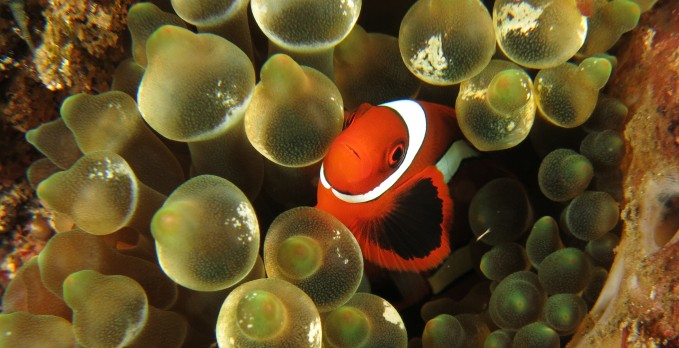
The first “underwater” experience that I remember vividly was the submarine ride at Disneyland probably because of the giant clam. We stockpile these images, and it is never clear when they might reappear in our life. For me, it would be over 30 years later when I, as a diver, would see a giant clam for real in the Great Barrier Reef. The first thought that entered my head (I don’t know why…) was that Walt Disney was no dreamer; he was a traveller. A giant clam did not emerge from his imagination; it was something that he (or someone from his team) really saw. At that moment, I realized how much scuba diving could influence my life.
It is hard to know if that was the image that put the idea of scuba diving into my head or Jacques Cousteau on TV and the repeated trips to tropical places to avoid Midwest winters. I did watch a lot of Jacques Cousteau, but I realize that I had no idea as a child that he invented the technology so that someone as ordinary as me could also become an underwater tourist.
I guess it was an evolution, from being a “tadpole” at swimming lessons, to a snorkeler, and finally a diver. I didn’t realize that diving was possible for someone like me until a trip to Hawaii. The final words on a snorkel catamaran cruise in Hawaii from the guide were, “I think you would really love scuba diving.” Amazing, I can not even remember the guy’s name and what an influence he had on my life. I was on my way to Nashville, Tennessee for my first postdoc so it was not exactly clear to me how I was going to do that in a Midwestern town that was 8 hours from the ocean. I was more likely to learn to sing about it than actually do it, but luckily, Vanderbilt actually offered a diving course both semesters.
The course was unusual in a couple of ways. First of all, it was YMCA, not PADI, and my course was taught by retired policemen, not some bronzed dudes who had figured out how to have a life in an exotic tropical place. The policemen were actually formerly the search and rescue squad (or more likely search and recovery), and frankly this fact was kind of intimidating for a first time diver. I wasn’t exactly sure what I was getting into, but I had my eye on being able to peer at the reef without having to pop up for air every 2 minutes. It was an 8-week course, which is unheard of, but we had plenty of time to make mistakes in the pool or with setting up and taking down our equipment. For some reason, their methods stuck in my head, probably the repetitive nature of the course; we had time to perform the same drills over and over again so that they were second nature, and I still go through that with each of my dives.
Easy enough to pass the classwork part of the course. It is just a bit of science after all. Now we had to set up our own equipment and take the plunge, a real responsibility for our own life in the wild. I mentioned that I took the class in Tennessee, but I did not mention that I started the class in September. Add eight weeks to that and now you are clearly in November. Not a lot of diving options plus whatever it was going to be, it wasn’t going to be a warm day to remember. My first dive ever outside of a swimming pool was in a stone quarry just outside of Nashville. A rather inauspicious beginning. Not much was going to be in there, and if there was, it was not possible to see it. It was fresh water so as in the pool, we sank almost directly to the bottom and dragged ourselves through the silt like some kind of awkward bottom dweller. Although we were unlikely to see sea life, at least not the pleasant kind from our imaginations or Jacques Cousteau, we were told beforehand that people were known to cast things out here. The “people” were often criminals, so in fact it was a warning that we might find weapons or other evidence that criminals were known to hide here. One more thing to be worried about: being shot in a stone quarry outside of Nashville while scuba diving. Another lesson, though that has stuck with me, do not touch anything. The not to touch part is something I would hear on my future dive trips, but that was because of critters, not guns or knives.
It was all much less dramatic. My dive buddy and I passed the buddy breathing and the taking off of your mask and then proceeded to explore a bit, although I felt as if I wanted a tether of some sort because we immediately lost each other and seemed to break one of the cardinal rules of dive class. Fortunately for the most part, we only saw green gook, and most importantly we survived!
A second part of the check out dives took place in fresh water springs in Florida. It is a straight 8-hour drive from Nashville to the panhandle in Florida so it was possible to finish our check out dives in the Gulf of Mexico. Weather did not comply so the policemen improvised and we dove Vortex Springs in Florida. The springs were a step up from the quarry, but I would not exactly consider them to be an inspiring dive site. It was still cold, dark, and murky. Some strange looking fish (and a lot of divers), but only a few, so my dive buddy and I spent most of our time swimming around in a circle (the vortex I guess) and inspecting crevices and the entrance to a small cave. At the end of the second day and after the stone quarry bit, I didn’t exactly walk away with the most positive ideas about scuba diving. In fact, I specifically remember thinking if this is what it is like, I don’t think I am going to like it.
Of course that was not the end; it was just a beginning. I had a dive day in Maui within the first year, but it was the trip to the Great Barrier Reef that made me realize that diving was not only a cool sport, but a tremendous way to move around the world. It had been a long time in between dives, but I was not going to miss the Great Barrier Reef. I skipped bungee jumping in the birthplace of bungee jumping in New Zealand on the way over because I was not willing to risk a detached retina; I wanted to take no chances with my ability to experience the Great Barrier Reef. In some ways, the most impressive part of seeing the Great Barrier Reef is in flying over it. It extends a great distance so that if you have a flight from Auckland to Cairns as I did and a clear day, you get to view it for about two thirds of the flight. Well of course it is the one living organism that can be viewed from outer space.
For real though, I was hooked on scuba diving after one day on the Great Barrier Reef. It was a high speed boat out from Cairns for the day, and Japanese divers were throwing up all around me. But when I jumped in and saw the giant clam, it was over for me. I altered my trek through Queensland, Australia so that I could go out to Heron Island which is an atoll on the reef. Some fairly interesting events took place while I was there. Two things I remember pretty clearly – manta rays and their stingray friends put on quite a display while we sat on the white sandy bottom and watched as they swooped over us and intermingled. The second thing I remember discovering was a wobbegong shark. I didn’t have a clue what I was looking at (you can’t forget that face the first time you see one), until many years later on one of my trips to Indonesia.
One other event was unrelated to marine life but impressed upon me the importance of having your own equipment. I had an ill fitting mask which was adjusted by a dreamy dive guide who clamped onto me in a fast current (that part was not so bad), but my take home message from that event was that I better get my own equipment because familiarity with the equipment will only help to avert any potentially panic situation underwater.
I did make one major blip in my new travel philosophy: I chose Norway for my out of country work experience. Norway has endless dive opportunities (and people are crazy for diving there), as it is surrounded by the sea. Dive sites are spectacular fjords above but otherwordly below the sea because sea stars, anemones, and a whole lot of other sea life grows out from the mountain walls. Diving there is incredibly unique, but the water temperature is also around 8°C. It means a lot of extra equipment and weight and well, you are just plain cold underwater. I took some advantage of diving there, not enough certainly, but Norway had a tremendous influence on my dive travel life regardless.
I was trying to use any tool that I could to learn Norwegian even though I didn’t have to, as Norwegians speak flawless English (except for the words fun and funny). There is a Norwegian dive magazine, Dykking, so I would pick it up to add to my vocabulary. The stories and photos were spectacular. I decided to contact one of the Norwegian underwater photographers who frequently wrote for the magazine. I just asked where his favorite place was to dive. He wrote back (amazing in and of itself that he would write to a stranger), “go to Indonesia”. I had read about Indonesia for sure, but I didn’t think I was brave enough to travel there, let alone dive there. He convinced me that I could do it, and it would be an exceptional experience. It changed my life. Once you are on that circuit, every time you travel to Indonesia someone tells you about another place that you absolutely must dive.
So that is my story, but I am always more curious about how other people have become divers, even islanders. With the sea all around, to be in it would seem to me to be a necessary part of living on an island, but it is not always the case. An Indonesian dive guide once described in very animated gestures how his older brother, already a scuba diver, told him to put on the mask, pinch his nose and blow, and just breathe. He then told me that their father could not even swim. Another islander came from a family with a historical impact on diving in the Philippines so he had an early start as a diver. I am not exactly sure how he could have stood up with a tank on his back at the age of eight but that is when he started. One woman I met got a scuba diving course as a gift from a husband who was about to divorce her and knew she was terrified of water. I have only had moderate success convincing my own friends to do it, but one decided to try it and is now a dive instructor.
For me, diving has become the basis for my travels. I always loved to swim, to be in the ocean (warm ones), the scientific aspect of it (curiosity about marine life), no talking necessary but you always have a social group to drop into when you travel, and I have discovered photography. It is in some respects a metaphor for how to live life on land – just take the jump and see what there is. That is how far I have come from that dreadful day in the stone quarry.
What is your dive story? Let us know in the Scubaverse Forum.
Blogs
Northern Red Sea Reefs and Wrecks Trip Report, Part 3: The Mighty Thistlegorm

Jake Davies boards Ghazala Explorer for an unforgettable Red Sea diving experience…
Overnight, the wind picked up, making the planned morning dive a bit bumpy on the Zodiacs to the drop point on Thomas Reef. There, we would dive along the reef before descending through the canyon and then passing under the arch before ascending the wall with a gentle drift. The site provided great encounters with more pelagic species, including shoals of large barracuda, tuna, and bigeye trevally.
Once back on the boat, it was time to get everything tied down again as we would head back south. This time, with the wind behind us, heading to Ras Mohammed to dive Jackfish Alley for another great gentle drift wall dive before then heading up the coast towards the Gulf of Suez to moor up at the wreck of the Thistlegorm. This being the highlight wreck dive of the trip and for many onboard, including myself, it was the first time diving this iconic wreck. I had heard so much about the wreck from friends, and globally, this is a must on any diver’s list. Fortunately for us, there was only one other boat at the site, which was a rarity. A great briefing was delivered by Ahmed, who provided a detailed background about the wreck’s history along with all the required safety information as the currents and visibility at the site can be variable.

Kitting up, there was a lot of excitement on deck before entering the water and heading down the shoreline. Descending to the wreck, there was a light northerly current which reduced the visibility, making it feel more like the conditions that can be found off the Welsh coast. At 10m from the bottom, the outline of the wreck appeared as we reached the area of the wreck which had been bombed, as our mooring line was attached to part of the propeller shaft. Arriving on deck, instantly everywhere you looked there were many of the supplies which the ship was carrying, including Bren Carrier tanks and projectiles that instantly stood out.

We headed around the exterior, taking a look at the large propeller and guns mounted on deck before entering the wreck on the port side to take a look in the holds. It was incredible to see all the trucks, Norton 16H, and BSA motorcycles still perfectly stacked within, providing a real snapshot in time.

Overall, we had four dives on the Thistlegorm, where for all of the dives we were the only group in the water, and at times, there were just three of us on the whole wreck, which made it even more special, especially knowing that most days the wreck has hundreds of divers. Along with the history of the wreck, there was plenty of marine life on the wreck and around, from big green turtles to batfish, along with shoals of mackerel being hunted by trevally. Some unforgettable dives.

The final leg of the trip saw us cross back over the Suez Canal to the Gobal Islands where we planned to stay the night and do three dives at the Dolphin House for the potential of sharing the dive with dolphins. The site, which included a channel that was teeming with reef fish, especially large numbers of goatfish that swam in large shoals along the edge of the reef. These were nice relaxing dives to end the week. Unfortunately, the dolphins didn’t show up, which was okay as like all marine life they are difficult to predict and you can’t guarantee what’s going to be seen. With the last dive complete, we headed back to port for the final night where it was time to clean all the kit and pack before the departure flight the next day.

The whole week from start to finish on Ghazala Explorer was amazing; the boat had all the facilities you need for a comfortable week aboard. The crew were always there to help throughout the day and the chefs providing top quality food which was required after every dive. The itinerary providing some of the best diving with a nice mixture of wreck and reef dives. I would recommend the trip to anyone, whether it’s your first Red Sea liveaboard in the Red Sea or you’re revisiting. Hopefully, it’s not too long before I head back to explore more of the Red Sea onboard Ghazala Explorer.

To find out more about the Northern Red Sea reef and wrecks itineraries aboard Ghazala Explorer, or to book, contact Scuba Travel now:
Email: dive@scubatravel.com
Tel: +44 (0)1483 411590
Photos: Jake Davies / Avalon.Red
Blogs
Northern Red Sea Reefs and Wrecks Trip Report, Part 2: Wall to Wall Wrecks

Jake Davies boards Ghazala Explorer for an unforgettable Red Sea diving experience…
The second day’s diving was a day full of wreck diving at Abu Nuhas, which included the Chrisoula K, Carnatic, and Ghiannis D. The first dive of the day was onto the Chrisoula K, also known as the wreck of tiles. The 98m vessel remains largely intact where she was loaded with tiles which can be seen throughout the hold. The stern sits at 26m and the bow just below the surface. One of the highlights of the wreck is heading inside and seeing the workroom where the machinery used for cutting the tiles are perfectly intact. The bow provided some relaxing scenery as the bright sunlight highlighted the colours of the soft coral reef and the many reef fish.

Following breakfast, we then headed to the next wreck, which was the Carnatic. The Carnatic is an 89.9m sail steamer vessel that was built in Britain back in 1862. She ran aground on the reef back in 1869 and remains at 27m. At the time, she was carrying a range of items, including 40,000 sterling in gold. An impressive wreck where much of the superstructure remains, and the two large masts lay on the seafloor. The wooden ribs of the hull provide structures for lots of soft corals, and into the stern section, the light beams through, bouncing off the large shoals of glass fish that can be found using the structure as shelter from the larger predators that are found outside of the wreck.

The final wreck at Abu Nuhas was the Ghiannis D, originally called ‘Shoyo Maru,’ which was 99.5m long and built in Japan back in 1969 before becoming a Greek-registered cargo ship in 1980. The ship then ran aground on the reef on April 19th, 1983, and now sits at the bottom at a depth of 27m. Heading down the line, the stern of the ship remains in good condition compared to the rest of the hull. The highlight of the wreck, though, is heading into the stern section and down the flights of stairs to enter the engine room, which remains in good condition and is definitely worth exploring. After exploring the interior section of the ship, we then headed over to see the rest of the superstructure, where it’s particularly interesting to see the large table corals that have grown at the bow relatively quickly considering the date the ship sank. After surfacing and enjoying some afternoon snacks, we made sure everything was strapped down and secured as we would be heading north and crossing the Gulf of Suez, where the winds were still creating plenty of chop.

The next morning, it was a short hop to Ras Mohammed Nature Reserve for the next couple of days of diving. The 6am wake-up call came along with the briefing for the first site we would be diving, which was Shark & Yolanda. The low current conditions allowed us to start the dive at Anemone City, where we would drift along the steep, coral-filled wall. These dives involved drifts, as mooring in Ras Mohammed wasn’t allowed to protect the reefs. As a dive site, Shark & Yolanda is well-known and historically had a lot of sharks, but unfortunately not so many in recent years, especially not so early in the season. However, there was always a chance when looking out into the blue.

The gentle drift took us along the steep walls of the site, with plenty of anemone fish to be seen and a huge variety of corals. It wasn’t long into the dive before we were accompanied by a hawksbill turtle, who drifted with us between the two atolls before parting ways. Between the two reefs, the shallow patch with parts of coral heads surrounded by sand provided the chance to see a few blue-spotted stingrays that were mainly resting underneath the corals and are always a pleasure to see. With this being the morning dive, the early sunlight lit up the walls, providing tranquil moments. Looking out into the blue, there was very little to be seen, but a small shoal of batfish shimmering underneath the sunlight was a moment to capture as we watched them swim by as they watched us.

Towards the end of the dive, we stopped at the wreck of the Jolanda where the seafloor was scattered with toilets from the containers it was carrying. This provided a unique site to make a safety stop, which was also accompanied by a large barracuda slowly swimming by, along with a hawksbill turtle calmly swimming over the reef as the sun rays danced in the distance.
For the next dive, we headed north to the Strait of Tiran to explore the reefs situated between Tiran Island and Sharm El Sheik, which were named after the British divers who had found them. We started on Jackson before heading to Gordons Reef, where we also did the night dive. All the atolls at these sites provided stunning, bustling coral reefs close to the surface and steep walls to swim along, which always provided the opportunity to keep an eye out for some of the larger species that can be seen in the blue. Midwater around Jackson Reef was filled with red-toothed triggerfish and shoals of banner fish, which at times were so dense that you couldn’t see into the blue. Moments went by peacefully as we enjoyed the slow drift above the reef, watching these shoals swim around under the mid-afternoon sun.

The night dive at Gordon’s Reef was mainly among the stacks of corals surrounded by sand, which was great to explore under the darkness. After some time circling the corals, we came across what we were really hoping to find, and that was an octopus hunting on the reef. We spent the majority of the dive just watching it crawl among the reef, blending into its changing surroundings through changes in colour and skin texture. It’s always so fascinating and captivating to watch these incredibly intelligent animals, in awe of their ability to carry out these physical changes to perfectly blend into the reef. Before we knew it, it was time to head back to the boat to enjoy a well-deserved tasty dinner prepared by the talented chefs onboard.
Check in for the 3rd and final part of this series from Jake tomorrow!
To find out more about the Northern Red Sea reef and wrecks itineraries aboard Ghazala Explorer, or to book, contact Scuba Travel now:
Email: dive@scubatravel.com
Tel: +44 (0)1483 411590
Photos: Jake Davies / Avalon.Red
-

 News3 months ago
News3 months agoHone your underwater photography skills with Alphamarine Photography at Red Sea Diving Safari in March
-

 News3 months ago
News3 months agoCapturing Critters in Lembeh Underwater Photography Workshop 2024: Event Roundup
-

 Marine Life & Conservation Blogs2 months ago
Marine Life & Conservation Blogs2 months agoCreature Feature: Swell Sharks
-

 Blogs2 months ago
Blogs2 months agoMurex Resorts: Passport to Paradise!
-

 Blogs2 months ago
Blogs2 months agoDiver Discovering Whale Skeletons Beneath Ice Judged World’s Best Underwater Photograph
-

 Gear Reviews3 months ago
Gear Reviews3 months agoGear Review: Oceanic+ Dive Housing for iPhone
-

 Marine Life & Conservation2 months ago
Marine Life & Conservation2 months agoSave the Manatee Club launches brand new webcams at Silver Springs State Park, Florida
-

 News3 months ago
News3 months agoWorld’s Best Underwater Photographers Unveil Breathtaking Images at World Shootout 2023


